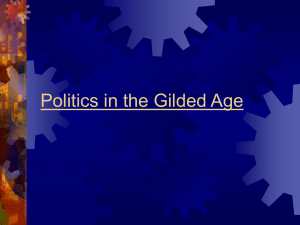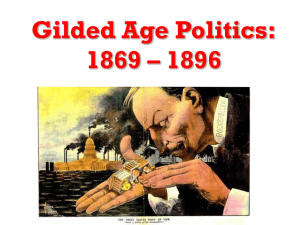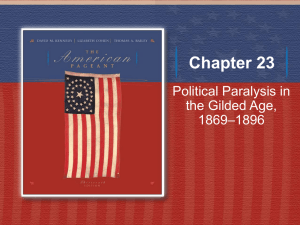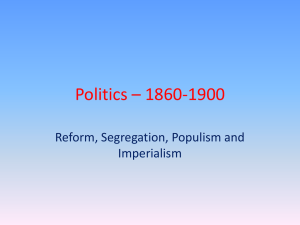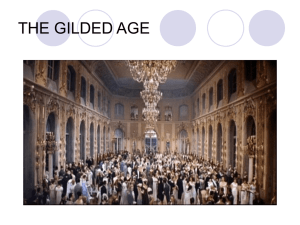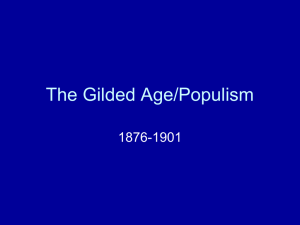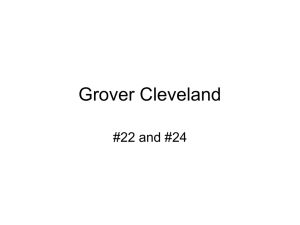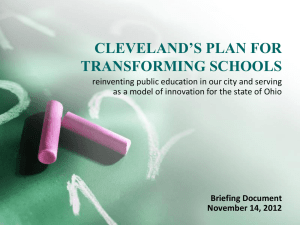Gilded Age Politics
advertisement
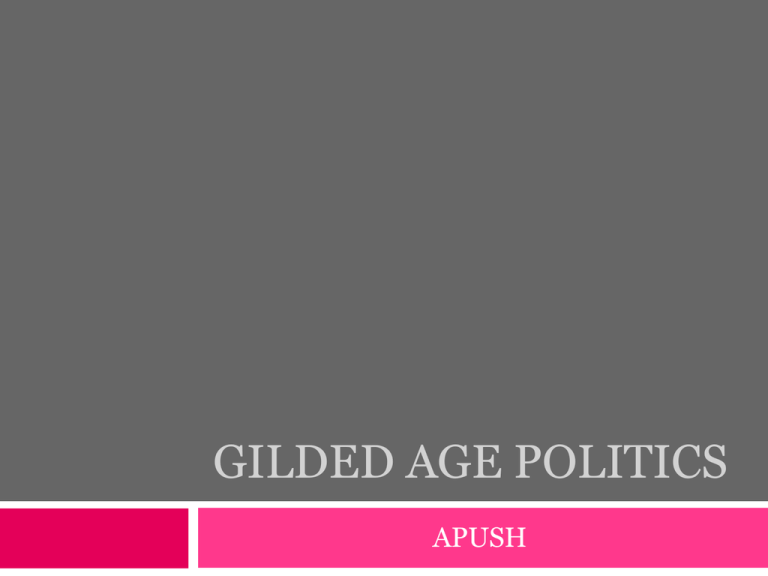
GILDED AGE POLITICS APUSH The “Politics of Equilibrium” A Two-Party Stalemate Well-Defined Voting Blocs Democrats White Southerners Catholics Recent immigrants Urban working poor Most farmers Republicans Northern whites African Americans Northern Protestants Old WASPs Most of the middle class Presidency as a Symbolic Office Party bosses ruled Presidents should avoid offending any factions within their own party The President just doled out federal jobs Grant Administration 1868-1876 1868 Presidential Election Grant Scandals & Grantism The Tweed Ring in NYC Who Stole the People’s Money? 1872 Presidential Election Check Point In the presidential election of 1868, Ulysses S. Grant A. transformed his personal popularity into a large majority in the popular vote B. owed his victory to the votes of former slaves C. gained his victory by winning the votes of the majority of whites D. demonstrated his political skill E. All of these New York’s notoriously corrupt Boss Tweed was finally jailed under the pressure of A. New York Times exposes and the cartoons of Thomas Nast B. federal income tax evasion charges C. the RICO racketeering act D. new York City’s ethics laws E. testimony by Tweed’s partners in crime The Credit Mobilier scandal involved A. B. C. D. E. public utility company bribes Bureau of Indian Affairs payoffs railroad construction kickbacks evasion of excise taxes on distilled liquor manipulating the Wall Street stock market During the Gilded Age, the Democrats and the Republicans A. had few significant policy differences B. agreed on currency policy but not the tariff C. disagreed primarily over the power of the federal government D. held similar views on all economic issues except for civil-service reform E. were divided over silver vs. gold currency During the Gilded Age, the lifeblood of both the Democratic and Republican parties was A. B. C. D. E. the Grand Army of the Republic the Roman Catholic Church ideological commitment big-city political machines political patronage Hayes Administration 1876-1880 1876 Presidential Election The Political Crisis of 1877 “Corrupt Bargain” Part II? Hayes Prevails Rutherford B. Hayes Ended Reconstruction Use of Federal troops to put down RR strike Civil Service Reform Southern Democrats appointed to cabinet Garfield Administration 1880-1881 1880 Presidential Election James Garfield Laissez Faire Star Route Scandal Spoils System 1881: Garfield Assassinated! Charles Guiteau: I am a Stalwart, and Arthur is President now! Chester Arthur Chinese Exclusion Act Pendleton Act Pendleton Act (1883) Civil Service Act The “Magna Carta” of civil service reform 1883 – 14,000 out of 117,000 federal government jobs became civil service exam positions 1900 – 100,000 out of 200,000 civil service federal government jobs Republican “Mugwumps” Reformers who wouldn’t re-nominate Arthur Reform to them – create a disinterested, impartial government run by an educated elite like themselves Social Darwinists Laissez faire government to them: Favoritism and the spoils system seen as government intervention in society Their target was political corruption, not social or economic reform! The Mugwumps Men may come and men may go, but the work of reform shall go on forever. Check Point The Compromise of 1877 resulted in A. a renewal of the Republican commitment to protect black civil rights in the South B. the withdrawal of federal troops and abandonment of black rights in the South C. The election of a Democrat to the presidency D. Republican support for an inflationary slivermoney policy E. a plan to build the first transcontinental railroad Abraham Lincoln was the first president to be assassinated while in office; the second was A. B. C. D. E. Rutherford Hayes William McKinley Chester Arthur Benjamin Harrison James Garfield The Pendleton Act required people applying for many federal government jobs to A. take a competitive examination B. present a written recommendation from a congressman or senator C. agree to make financial contributions to their political party D. submit a resume listing their experience and providing references E. have a college degree With the passage of the Pendleton Act, prohibiting political contributions from many federal workers, politicians increasingly sought money from A. new immigrants B. contractors doing business with the federal government C. factory workers and farmers D. foreign contributors E. big corporations Cleveland Administration 1884-1888 1884 Presidential Election 1884 Presidential Election Grover Cleveland (D) James Blaine (R) A Dirty Campaign Ma, Ma…where’s my pa? He’s going to the White House, ha…ha…ha…! Little Lost Mugwump Blaine in 1884 Cleveland’s First Term The “Veto Governor” from New York First Democrat elected since 1856 A public office is a public trust! His laissez-faire presidency: Opposed bills to assist the poor as well as the rich Vetoed over 200 special pension bills for Civil War veterans! The Tariff Issue After the Civil War, Congress raised tariffs to protect new United States industries Big business wanted to continue this; consumers did not 1885 – tariffs earned the US $100 million in surplus President Cleveland’s views on tariffs??? Tariffs became a major issue in the 1888 presidential election Harrison Administration 1888-1892 1888 Presidential Election 1888 Presidential Election Grover Cleveland (D) Benjamin Harrison (R) Coming Out for Harrison Benjamin Harrison Billion Dollar Budget McKinley’s Tariff Pursued Annexation of Hawaii Cleveland Administration (again) 1892-1896 1892 Presidential Election 1892 Presidential Election Cleveland (again) Harrison Cleveland Loses Support Fast! The only President to serve two nonconsecutive terms Blamed for the 1893 Panic Defended the gold standard Used federal troops in the 1894 Pullman strike Refused to sign the Wilson-Gorman Tariff in 1894 Repealed the Sherman Silver Purchase Act Check Point The sequence of presidential terms of the “forgettable presidents” of the Gilded Age (including Cleveland’s two nonconsecutive terms) was A. B. C. D. E. Cleveland, Hayes, Harrison, Cleveland, Arthur, Garfield Garfield, Hayes, Harrison, Cleveland, Arthur, Cleveland Cleveland, Garfield, Arthur, Hayes, Harrison, Cleveland Hayes, Garfield, Arthur, Cleveland, Harrison, Cleveland Hayes, Garfield, Harrison, Cleveland, Arthur, Cleveland Which one of the following Gilded Age presidents had a different party affiliation from the other four? A. B. C. D. E. Ulysses S. Grant Rutherford Hayes Grover Cleveland Benjamin Harrison Chester Arthur Besides advocating a lower tariff, Grover Cleveland stirred political opposition by A. B. C. D. supporting free and unlimited coinage of silver advocating federal aid to farmers vetoing many veterans’ pension bills spending the federal budget surplus on public works E. bringing his mistress and illegitimate child to live in the White House The Billion-Dollar Congress quickly disposed of rising government surpluses by A. B. C. D. E. providing subsidies to wheat, corn, & cotton farmers building an expensive new steel navy expanding pensions for Civil War veterans cutting tariffs and other taxes increasing spending on railroads and other transportation projects The major campaign issue of the 1888 presidential election was A. B. C. D. E. civil-service reform the big trust question the currency question foreign policy tariff policy
